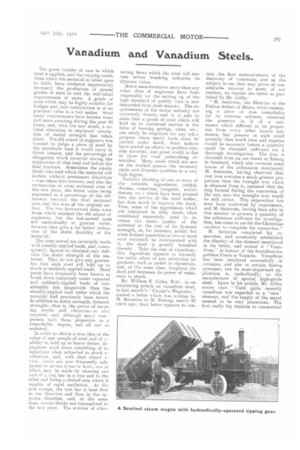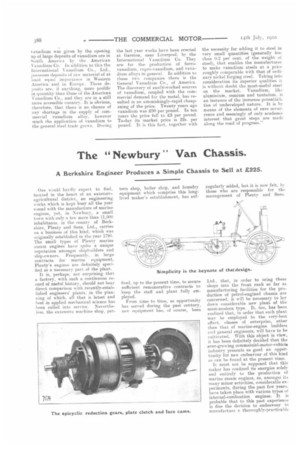Vanadium and Vanadium Steels.
Page 3

Page 4

If you've noticed an error in this article please click here to report it so we can fix it.
The great variety of uses to which steel is applied, anu the varying conditions whim the material is called upon to fulfil, have rendered imperatively necessary the production of special grades of steel to suit the individual requirements of users. A grade of steel which may be highly suitable for bridges and roof construction is of no practical value to a tool maker. Steel users' requirements have become more and more exacting during the past '20 years, and, with the new steels, a decided alteration in engineers' conception of useful strength has taken place. The old school of engineers was content to judge a piece of steel by the maximum load it would carry in direct tension, and the percentage of elongation which occurred during the application of that load and before the final fracture. Sometimes the elastic limit—the load which the material will sustain without permanent distortion --was taken into account, and also the contraction of cross sectional area of the test piece, the latter value being expressed as a percentage of the ditference between the final sectional urea and the area of the original section. The two first-named tests were those which satisfied the old school of engineers, but the last-named tests are undoubtedly of greater value, because they give a far better indication of the static ductility of the material, The tests named are invariably made with steadily applied loads, and, conssquently, figures so obtained only indicate the static strength of the material. They do not give any guarantee that such steel will hold up to shock or suddenly applied loads. Steel parts have frequently been known to break down completely under repeated and suddenly-applied loads of considerably less .magnitude than the steadily-applied load under which the material had previously been tested. In addition to static strength, dynamic strength—that is, the power of res'st_ ing shoeks and vibra0on—is ako required, and, although inasy stee possess both these properties to a remarkable degree, not all are so endowed.
In order to obtain a true idea of the value of any sample of steel and of it ability to hold lip to heavy duties, th engineer must know something of its behaviour when subjected to shock vibration. and, with that object is yiew, steels are nonfrequently subjected to severe dynairie tests, one of which may be made. by securing one end of a test bar in a vice and to the other end fixing a slotted arm which is capable of rapid oscillation. As the arm swings, the test bar is bent first in one direction and then in the opposite direction, and, at the same time. severe shocks are transmitted to the test piece. The number of alter
paling blows which the steel will sustain before breaking indicates its dynamic Value.
Motor manufacturers more than any other class of engineers have been responsible for the setting up of the high standard of quality that is now demanded from steel makers. The requirements of the motor industry are extremely drastic, and it is safe to state that a grade of steel e /deli will hold up to continued service in the form of bearing springs, axles, etc., can safely be employed tor any °tilts purpose where heavy loads must be carried under shock. Steel makers have spared no efforts to produce suitable material, and great credit is due to them for their painstaking researches. Many steels which are now on the market possess the necessary static and dynamic qualities to a very high degree.
Suitable blending of one or more of the valuable ingredients (nickel, chrome, vanadium, tungsten, molybdenum, etc.) which have been pressed into the service of the steel maker, has done much to improve the stock, True, some of the ingredients which are contained in alloy steels, when considered separately, tend to in_ crease the static quality of the material at the cost of its dynamic strength, as, for instance, nickel, but when defined quantities of two or more such materials be incorporated with it, the steel is greatly benefited thereby. Take the case of vanadium : this ingredient appears to intensify the static effect of any particular ingredient, such as nickel or chromium. and, at the same time, toughens the steel and increases its power of resistance to shock.
Mr. William E. Gibbs, B.Sc., in an interesting article on vanadium steel, in last month's " Cassier's Magazine." quoted a letter which was written by /3'
M. Berzelins to M. Dulong, nearly 0 years ago ; that letter appears to con
tain the first announcement of the discovery of vanadium, and as the subject is one that may prove of considerable interest to many of our readers, we reprint the letter as published by Mr. siibbs:
" M. Sefstrom, the Director of the Fahlun School of Mines, while examining a piece of iron remarkable for its extreme softness, observed the presence in it of a substance which differed in its proper. ties front every other known substance, but present in such small quantity that much time and expense would be necessary before a quantity could be obtained sufficient for a thorough investigation. The iron is obtained from an ore found at Taberg in Smaland, which also contains some traces of the substances mentioned. M. Sefstrom, having observed that cast iron contains a much greater proportion than the wrought iron which is obtained from it, assumed that the slag formed during the conversion of the cast into the wrought iron would be still richer. This supposition has soon been confirmed by experiment, and M. Sefstriim, having been able in this manner to procure a quantity of the substance sufficient for investigation, has come to me for the Christmas vacation to complete his researches."
M. Sefstrom completed his researches, and eventually established the identity of the element mentioned in his letter, and named it "Vanadium," in honour of the Scandinavian goddess Freya or Vanadis. Vanadium has been employed successfully in ceramics, and also in certain dyeing processes, but its most-important application is, undoubtedly, to the manufacture of special high-grade steel. Later in his article, Mr. Gibbs states that " Until quite recently vanadium was regarded as a 'rare ' element, and the supply of the metal seemed to be very precarious. The first really big impetus to commercial
vanadium was given by the opening up of large deposits of vanadium ore in South America by the American Vanadium Co. In addition to this the International Vanadium Co., Ltd., possesses deposits of ra a material of at least equal importance in Western America and in Europe. These deposits are, if anything, more prolific in quantity than those of the American Vanadium Co., and they are in a still more accessible country. It is obvious, therefore, that there is no chance of any shortage in the supply of commercial vanadium alloy, however much the application of vanadium to the general steel track grews. During the last year works have been erected at Garston, near Liverpool, by the International Vanadium Co. They are for the production of ferrovanadium, cnpro-vanadium, and vanadium alloys in general. In addition to these two companies there is the General Vanadium Co., of America. The discovery of easily-worked sources of vanadium, coupled with the commercial demand for the metal, has resulted in an astonishingly-rapid cheapening of the price. Twenty years ago vanadium was £90 per pound. In ten years the price fell to £3 per pound. To-day its market price is 22s. per pound. It is this fact, together with the necessity for adding it to steel in very small quantities (generally less. than 0.2 per cent, of the weight of steel), that enables the manufacturer to make vanadium steels at a price roughly comparable with that of ordinary nickel forging steel. Taking into consideration its superior qualities it is without doubt the most-useful steel on the market. Vanadium, like aluminium, osmium and tantalum, is an instance of the immense potentiali_ ties of undeveloped nature. It is by means of the elements of rare occurrence and seemingly of only academic interest that great steps are made along the road of progress."




















